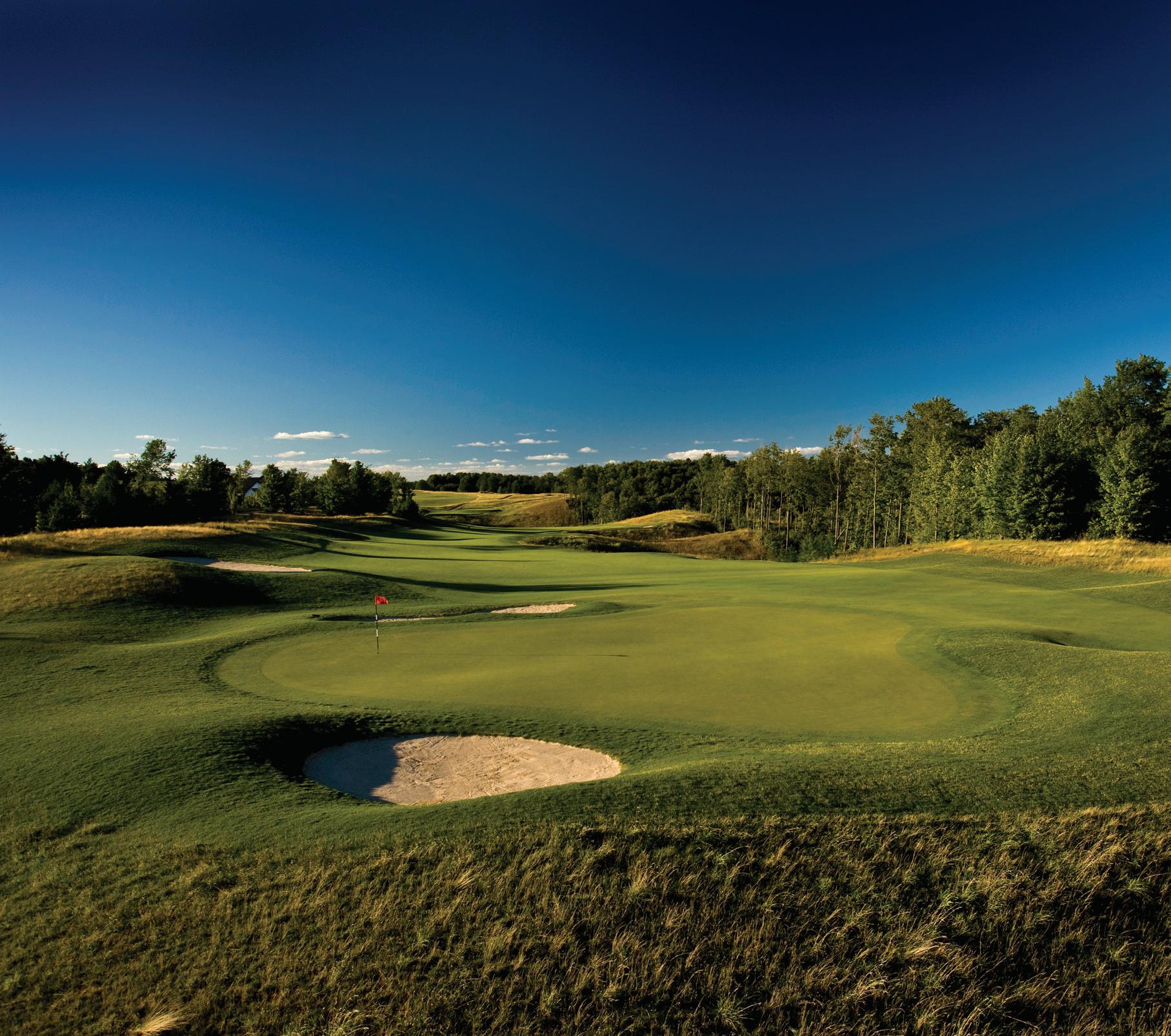
27 minute read
TRAVEL PLANNING
Travel There and Back can set up a golf dream trip to the tropics, the British Isles or anywhere in the world within your budget.



Travel There and Back brings expertise and passion to golfers consumed by wanderlust
or the past six years, Michelle Wicks Cypher and her husband Michael have been F turning imagination into memories at their Monroe, Wash.-based agency Travel There and Back. Folks have come to them – mostly pre-COVID-19 — with thoughts, plans and bucket-list dreams involving faraway places and restorative adventures, which the Cyphers have then shaped into trips their clients will never forget.
“That’s the goal,” says Michelle. “It doesn’t matter what kind of trip it is. For the next 20 years they’ll be talking about that trip, that moment, or that memory.’’
We may not realize it, but most of us have a fanciful bucket-list of places we want to explore at some point in our lives, experiences we’d like to share, and rituals, customs and cultures we’d like to better understand. The Cyphers have built their business around that motivation, tapping into different bucket-list trends or, more accurately perhaps, a ‘cup’ list as they are providing a growing number of travel opportunities for golfers who want to play the world’s great golf courses.
The golf travel part of the business was motivated by the couple’s personal experiences. Michael loves to play when traveling, so they have put an emphasis on setting up tee-times at the places they visit. Primarily by word of mouth, friends and regular customers borrowed that idea thus incorporating golf into a growing number of travel plans. Then it evolved on a more personal level.
Michael’s father spent nearly a decade as his
BY BOB SHERWIN
wife’s caregiver. When she passed away, Michael and his brother celebrated their parents’ many years together by taking Dad to Pebble Beach. They realized many other people make similarly sentimental trips.
Golf trips are primarily made up of male, buddy foursomes seeking to walk the same fairways as golfing legends. They can stand on an ancient tee and imagine what it was like to play 250 or even 500 years earlier with gutta-percha balls and hickory-shafted clubs. Of course, when golfers talk nostalgically about golf history, the discussion invariably gets round to the Old Course in St. Andrews, Scotland where, in 1764 after centuries of play, the links was shortened from 22 holes to 18.
The Old Course is the ultimate destination, where everyone wants to play. So the Cyphers developed working relationships with two Scottish golf travel companies that can get their clients on the 1st tee in front of the famous Royal and Ancient clubhouse. Other classic Scottish links can be booked too.
Michelle says the couple’s success is the result of a “combination of our experience and connections with experts in the areas we travel to.” Scottish courses are the most requested, but Ireland, where golf has been played since the mid-18th Century, is also becoming popular. So too are courses in Continental Europe, Canada, and Mexico.
Michelle also likes to involve a cultural submersion in the trips she creates, giving her clients options tailored to the area. She would, for example, offer a post-golf tour of a whisky distillery in Edinburgh, Perth or the Highlands, or a beertasting session in Dublin or Killarney. “I believe when you travel internationally, it’s important to sample the local food and drink,” she says.
Wine-drinkers aren’t forgotten. The Cyphers plan domestic golf-based wine trips to eastern Washington wine country, Yakima and the TriCities, the Pinot Noir region of Oregon’s Willamette Valley or the Sonoma/Napa wine region of northern California.
“It’s the perfect way to combine our clients’ favorite things,” says Michelle. “There are great courses in those areas. It allows for a perfect pairing for mixed groups. There’s interest in golf and interest in other things.’’
Though Travel There and Back is not a golf travel agency, with only 25-30 percent of its business golf-related, the demand for golf trips is definitely on the rise as the world emerges from COVID-19. Golf has been a rare success story during the pandemic as golfers found they could socially distance easily in an outdoor setting. It’s low-impact exercise too, and it’s not necessary to spend much time indoors. “We’re anticipating getting really busy,’’ says Michelle.
“There’s a lot of pent-up demand. It’s starting already. I need to find out where in the world golf is open and where people can play.”
Their memories await. For information go to travelthereandback.com to learn more or book an appointment to set your dreams into motion.
Native Scotsman, now a U.S. citizen, David McLay Kidd
brings global perspective and talent to his course architecture leaving a wake of golfing wonders here and abroad
avid Mclay Kidd is one of the world’s foremost golf course architects, but he has never let success change him. A native Scotsman who now lives in our part of the world, he is still the same loud, gregarious, opinionated (his words) guy he always was. He was D good enough to share some of those opinions with us in this exclusive Q & A with editor Tony Dear.
When did you first come to the USA?
I came to the Golf Industry Show in Orlando in 1990. I was working for Howard Swan, a British architect. I was only a year out of college so didn’t really know anyone, but basically had an ‘in’ with anyone in the golf business because of my father (Jimmy Kidd was the longtime greenskeeper/course manager at Gleneagles in Scotland, one of the most famous hotel and golf resorts in the world and home to three courses one of which, the Jack Nicklaus-designed Centenary Course, hosted the 2014 Ryder Cup). He spent a lot of time over here and was in regular contact with the GCSAA, the PGA Tour etc., and knew everyone. So he was my secret weapon if you like.

It’s a story many readers will be familiar with, but remind us how the Bandon Dunes (Ore.) job happened. How did you feel about it? Did you think you were ready for it and capable of building a great course?
I was working for Gleaneagles. The idea was to develop Gleaneagles-type resorts around the world and I was the in-house course architect/project manager. My first job was actually in Nepal — that’s a long, crazy story involving the Royal family and civil war but I basically finished the design and got out. I never saw it completed (I played it about 15 years ago and can confirm it is really good).
Mike Keiser wanted to build authentic links golf so he decided he wanted a Scottish architect. I was really the only one. It was really in the capacity of Gleneagles Developments that Mike found me, but he was really looking for my dad whom he was aware of. They became firm friends.
When we started I was 26. At that age you think you can do anything. You can conquer the world. That first week we were there in July 1994 we figured out we were part of a whole parade of people that Mike might have chosen. As it came
David McLay Kidd's catalog of courses is an all-star lineup of links around the world.
time for us to leave, I thought there was no chance we’d get the job so I felt comfortable just coming right out and telling him what I thought. I gave him a list of the things he could do wrong — clubhouse on the clifftop, bent greens, carts, flowering cherry trees, all that. I said if he wanted it to be authentic, people would walk (in the crappy weather if need be), there be few flat lies, the bunkers would be rugged pot bunkers — real hazards, and it should be fescue. He looked at me very quizzically and the Kemper people (management company Keiser had hired) literally laughed at me. They thought I was suggesting an unworkable course in an unworkable place — a double whammy!
Mike was very curious about Sand Hills — Bill Coore’s and Ben Crenshaw’s new course in Nebraska which was very natural, a bit wild, and walking-only. He kept referring to that, Royal County Down in (Northern) Ireland, and Royal Dornoch in Scotland. The dunes were much softer than on those courses, but that was the sort of thing he wanted. Pure golf. In the end, I think he picked me because he knew my dad wouldn’t let me fail and because he felt that an American architect might not have seen the vision through entirely and that at some point they would have fallen back to something they were more familiar with — something more manicured and tidy.
What did you learn about American golf during your time at Bandon? And what did you learn about the world and yourself?
It’s evolving, but back then American golf had a pretty strict set of expectations. It still does to a degree but not as much. Courses had to look a certain way, specifically like Augusta National. If they didn’t they were automatically inferior. I had guys who knew their golf and would have been considered discerning, sophisticated golfers ask me why the conditions in Britain were so bad. They didn’t realize those conditions were like that on purpose. They weren’t bad, of course, they were just largely what Mother Nature gave you. The greenkeepers were no less able. They just had a different set of demands and a different philosophy with regard inputs and chemicals and all that. And I’d heard golf in America was played mostly through the air and discovered that was certainly true. In the UK, you think more about what the ball will do on the ground than what it’ll do in the air.
I learned a lot about how the world works, but the first thing was that a Scotsman and a guy from Oregon might speak the same language, but culturally they are very, very different. I would insult someone I liked to the very core of their being to show how much I cared about them. That’s fine in Britain but it didn’t go down very well here sometimes.
And I learned that if I was willing to attempt something, there might be some hiccups along the way, but I’d usually find a way to do it.
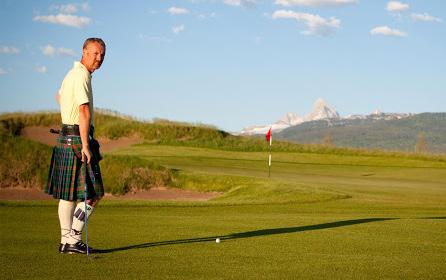
Gamble Sands

Tetherow
Were you immediately in demand after Bandon Dunes, or did it take another couple of smaller jobs before developers had 100 percent confidence in their decision to hire you?
Somewhere in between. I think Golfweek had put Bandon Dunes in its top ten before it even opened, and Golf Digest was calling me the next superstar. So it was a pretty big deal, but after it had opened I think I waited nine months before I got another job. Queenwood, near London, Powerscourt in Ireland, and Nanea in Hawaii all happened about the same time.
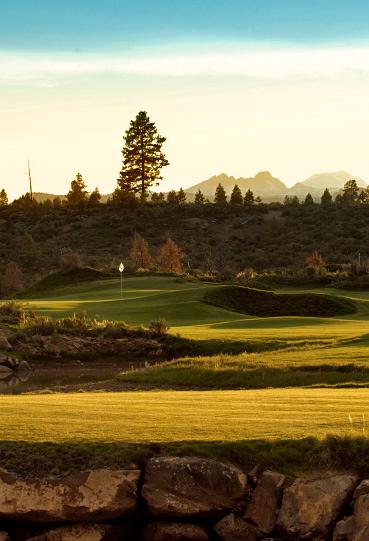
When did you move to Bend and why?
I had actually been to Sunriver in 1991. Gleneagles was looking to create something in the area and I met with the development team out there and stayed in a house on the Crosswater Club course. But I was only there a short time. Three or four years later, we were building Bandon and getting soaked to the skin every day when somebody suggested I take a trip out to the desert. I said ‘what desert? There’s no desert in Oregon.’ But they assured me there was. Even though I’d been to Sunriver, I really didn’t remember much so was a bit skeptical. But I took the five-hour drive over the mountains, and remember the weather changing dramatically as I made it over the top. It was like driving into Narnia. I had tried living in Bandon for a couple of years, but it was tough. It wasn’t great for travel and, though a storm is great if you’re visiting and want the authentic British links experience, it’s not great if you live there. In 2006, I was hired to design Tetherow. I used that as an excuse to relocate to Bend and I’ve been here ever since.
There’s a great story behind every project you’ve done, but what are the three most memorable besides Bandon Dunes?
Bandon Dunes was certainly memorable and I’ll be forever grateful to Mike for giving me the opportunity. But it wasn’t an ideal scenario at times. I was very much the new kid. Hell, I wasn’t even that. I had no track record at all, and was getting pushback from Mike’s retail golfer friends, colleagues, and advisors all the time. Gamble Sands was entirely different. I won the trust of the Gebbers Family entirely, almost to the point of feeling burdened by it. They put so much trust in me before I felt like I’d done enough to deserve it, and obviously didn’t want to let them down. I had my absolute A+ team working on it, and during the project I really felt re-energized with my love for golf course architecture. I wanted to push back at what had happened at Machrihanish Dunes, Tetherow, and the Castle Course. I think they’re great courses but, first and foremost, I wanted to build a course that was playable for the average golfer. I cast off all the expectations from the media, raters, and what golfers here expect golf to look like and went with what my gut told me to be right. It felt like the Traveling Wilburys. I had a team of people that were very good at what they do, but I got to be the leader of the band and create the parameters we worked around.
Another would be Nanea. I was in Scotland at the time I got the call and was in Hawaii 24 hours later. I’d never been to Hawaii, had never seen lava, and had not the slightest clue who Chuck Schwab or George Roberts were. It was another crazy, very unlikely set of circumstances like Bandon. I basically spent three days at the Four Seasons telling them I was in no way qualified for what they wanted me to do, but I think my telling them that made them all the more determined to hire me.
My third would be the Castle Course. That’s a helluva story — Home of Golf, municipal course, university town, the politics, all the cloak and dagger stuff that went on in the town, the Links Trust, the R & A, and within my own industry (Tom Doak rated it a ‘0’ in his Confidential Guide).

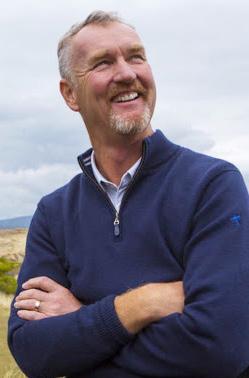

Tetherow
It’s so cool that a kid from Renfrewshire in Scotland has worked for some very prominent people. How did it all happen, and what’s it like working for Mike Keiser, Charles Schwab, Jon Huntsman Sr (Huntsman Springs now Tributary in Idaho), Dietrich Mateschitz (co-founder of Red Bull for whom Kidd built a course on the Pacific island of Laucala), Carlos Pellas (Nicaraguan billionaire businessman who hired Kidd to design Guacalito de la Isla), Cass Gebbers (Washington State orchardier and rancher who developed Gamble Sands)...?
Gleneagles was a place where the very wealthy would visit. And they all knew my dad — Jackie Stewart, Sean Connery, Princess Anne. Jack Nicklaus phoned our house and asked to speak with my dad a couple of times. I’m not saying I, or my dad was one of them, of course, but I felt comfortable around these people from a young age. You soon realize they’re just people, like you and me.

Do you have any particular favorites among the owners you’ve worked for?
They’re all great and I really don’t have a bad thing to say about any of them…well, maybe a couple. But Chuck Schwab is an absolute gem of a man. He’s a multi-billionaire obviously but genuinely cares about people and takes the time to find out about you. I remember sitting down and talking with him and him asking me about my family and how I became an architect and all that. And suddenly he asks what credit card I have and proceeds to tell me the benefits of changing to his card. That was odd. (Kidd then tells a story. I was in Hawaii and given the keys to his car. I was so naïve I thought it was his actual car, but of course it was for chefs, pilots and other staff members. I opened the glove box looking for some music and there was one CD. It was called ‘Buying a House with no Money Down”. I thought it was hilarious that Charles Schwab should have a CD about how to buy a house. It was years later that I realized it wasn’t his CD…or car.)
He’d be my No. 1 but I haven’t worked for anyone I didn’t like. I could enjoy a cup of coffee and a bacon sandwich in the kitchen with any of them. They’re all good people, and I think there was a mutual respect.
Oh sure. You do something they don’t and are one of the best at it so that’s understandable.
Well, I certainly hope so. It’s different when you’re working for existing clubs though (Kidd has done extensive work at Broken Top in Bend, Rolling Hills in Los Angeles, Rancho Santa Fe in San Diego, and has been renovating/redesigning Estrada at Snow Canyon in Utah in recent months) because the committee or board of directors that hires you is often different to that in place when you complete the job.
Besides the billionaires though, you’ve worked for municipal authorities, private clubs, semi-private clubs, and even the PGA Tour (TPC Stonebrae in California). How have you juggled all that?
I really like the fact I’ve been able to build courses for a range of entities, but yes, it can get quite complicated at times. Essentially, though, you’re working for one person maybe two and regardless of who they are or what they represent they still want the best course you can design. The problem comes when the golf course isn’t the absolute number one priority. Yes, a developer may want the best course of which you’re capable but it may be with a view to selling homes or filling hotel rooms. Then our priorities probably don’t align and there may have to be some tricky compromises.
You been in America for 20 years. Are you a citizen? And how often do you go back to Scotland?
I am and feel very humbled and honored to travel with my blue passport. I still have my red one (burgundy actually), but don’t use it much and obviously haven’t been able to for a while now. Before Covid, I was going to Scotland once a year on average. I don’t go there that often because my immediate family has moved. I have some aunts, uncles and cousins there, but my parents are in Essex, England now. My best friend from school lives in Scotland still and I see him. I actually just spoke to him on the phone this morning from 21,000 feet.
Ah yes, your plane. What is it, and how long have you been flying? What are the benefits?
It’s a Cirrus SR22T. I’ve been piloting my own plane since 2012. My quality of life is so much better because I’m not a slave to the airlines. It allows me to spend so much more time at home with my family and on a work site. Flying commercial meant having a very strict schedule. I could spend three maybe four days on-site then leave. With my own plane, I can fly to the site whenever I like pretty much and spend a day or two. So I can tweak and edit and control the development of the course much more closely. And it has allowed me to continue working in the Covid era.
I’ve only had my current plane for a year and haven’t taken it over the Rockies yet, but I flew my previous plane to the east coast several times. This week, I’ve flown over 3,000 miles going from Bend to St. George, Utah, down to San Diego, back to St. George, and finally back to Bend.

Gamble Sands

Tetherow
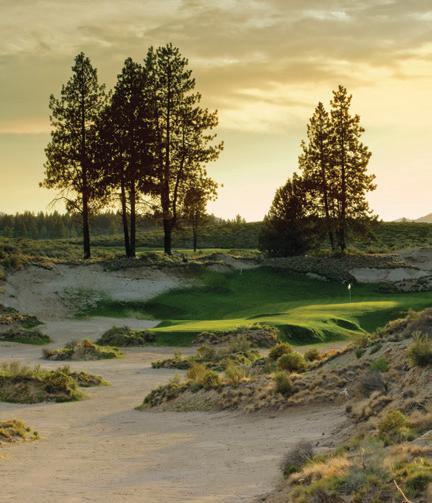
Bandon Dunes
You mentioned the courses you took some stick for — Machrihanish Dunes, Tetherow and Castle Course. What was your motivation for making them so tough? How/when did your shift in philosophy happen?
That was just what everyone was doing at the time. And it seemed all the great courses, or those ranked as the elite, were brutally hard. There was a definite theme in the media that golf was becoming too easy and would be overwhelmed by Tiger Woods and others. So terms like ‘Resistance to scoring’ became a thing. I remember going to Oakmont a few years ago and speaking with a lot of the members. Most of them said they all played at other clubs and would visit Oakmont a few times a year. It was an amazing experience to play such a great, historic course, but they wouldn’t want to do it often.
I began to realize golfers that weren’t elite ball-strikers — the 99.9 percent of us — obviously didn’t enjoy playing really tough courses. You could still make the course challenging but not to the point where your shot had to hit a very specific spot, where the margin for error was tiny, like we see at Augusta National. That’s for the best players in the world who get badly punished for missing targets by a very small margin. There’s obviously a place for courses like Oakmont. It’s over 100 years old and still ranked in the top ten in the world. But I decided that’s not what I want my legacy to be. I get excited by the fact the Castle Course is the second most popular in St. Andrews and the feedback we get from Gamble Sands or Mammoth Dunes.

You’re part of an elite group of architects that also includes Bill Coore, Ben Crenshaw, Tom Doak, and Gil Hanse. Give us a sense of the level of camaraderie/friendship/respect/competition there is between you.
As far as I’m concerned there is definitely a genuine respect. When I first came to the US, I didn’t really see anything that resonated. They weren’t bad courses necessarily, but I didn’t find anything that really spoke to me. They seemed a little formulaic and contrived. But that group of architects you mentioned quickly emerged and what they were doing absolutely resonated with me. I could see influences from the old country and I thought what they were doing was really, really good. I’m thrilled to be considered a part of that group and definitely conscious of trying to one-up them, or build something just as good as what they’re doing, every chance I get.
How often do you get to play and what’s your handicap? What are some of your favorite courses to play in the Pacific Northwest that you didn’t design?
I’m a highish single-figure golfer and will play anywhere. I’m not a course snob. I don’t play as much as I like, but who does? I went several months without picking a club up over the fall and winter then in March hosted two groups at Bandon in quick succession, playing every day for a week. But I won’t play now until the opening of Quicksands in May. I play a lot of golf at the Tom Weiskopf/Jay Morrish-designed Broken Top in Bend, but I think the best course in Central Oregon might be Crosswater. Bob Cupp and John Fought did an outstanding job there. I play all the Bandon courses as much as I can. And I like to play newly renovated courses to see what other architects are doing. They’re not in the Pacific Northwest, but I want to see what Kyle Phillips did at Hillcrest in Los Angeles, and what Weiskopf did at Torrey Pines North a few years ago. You can learn something every single time you visit a new course whether it be something you want to emulate or something to avoid.
Tell us about Quicksands — why are we going to love it?
I took what I thought was a novel view to the genre. The model in many cases seems to be taking regular-sized golf holes and shrinking them into miniature versions. There are many things you can do on a short course you absolutely could not do on a regular course, and I focused on them — a crater green, a boomerang, a corkscrew, a huge backboard, an 80-yard hole you could putt.
What about the third course at Gamble Sands; what needs to happen before work starts?
As you know, Gamble Sands is a tiny part of the Gebbers’s business. They are in no rush to get it done and a lot of other things need to happen to make the course workable. I routed it awhile ago, so it’s ready to be built, but for it to work there would need to be more rooms, more F & B outlets, more car park space, etc. All that doesn’t
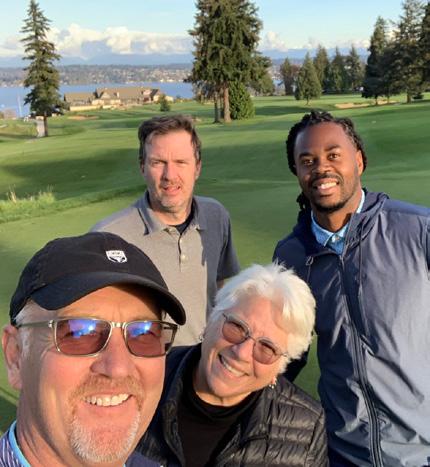


Kidd with author Tony Dear, NFL star Sidney Rice and golf journalist Anni Shelley at Seattle's Sand Point GC.
Gamble Sands Bandon Dunes

just happen overnight. Without it all, you’ll just have the same number of unique visitors who are already there to play the Sands Course just playing an extra round.
A lot of the old architects — Mackenzie, Braid, Fowler, etc. wrote down their guiding principles, their rules of design if you like. Have you ever done that?
No, I have not. My concern is that it sparked a chain reaction that led to the conformity of golf design. When Mackenzie wrote his principals it caused a lot of wannabe designers to follow his process to the letter with little regard for the site. They saw them as the Ten Commandments written by God. There have since been plenty of good architects and developers who regarded them as guidelines, not strict rules, and done great work and I think the person who has done most to break that is Mike Keiser.
How long has Nick Schaan been with you and what does he bring to the table?
He’s been with me for 15 years and can do a mountain of things I can’t. He’s very detailedoriented. He filters my big ideas, identifying the stuff that will work and discarding the stuff that won’t. If I were a writer he’d be my editor but that is doing him a disservice. He’s so much more than that. He’s a very good writer himself.
Favorite architect from the past? Have you modeled yourself on anyone in particular? Whose style would you say your work most resembles?
My dad was obsessed with the Great Triumvirate, especially James Braid. He is an encyclopedia on Braid. Harry Colt too. I grew up searching for and playing their courses, so I’m sure some of their characteristics rubbed off on me.
Your newest new-build project is Comporta Dunes in Portugal, but you actually designed it years ago. What’s the story there?
There’s a very famous family in Portugal called Espirito Santo. It goes back hundreds of years and has owned the biggest bank there for a long time. We were building the course for them, and it turned out the family’s patriarch Ricardo Espírito Santo Silva Salgado was embezzling billions of Euros. The course was a tiny part of the family’s extensive portfolio of businesses but construction just stopped. This was July 2014. We had begun grassing the front nine and were literally a couple of weeks from completing the job. I was also working on a course near London, called Beaverbrook, at the time and a house guest of the owner. One morning, he was reading the London Times, saw the story about Espirito Santo, and said “Isn’t that your client in Portugal?”
I flew to Portugal the following day and demanded we get paid for the work we’d already done. The head of the family’s development unit told me it was just a small problem and everything would be okay. But I said if he hadn’t paid me by the end of the day, I’d be stopping work and telling all my construction guys to go home. Next day, they tried fobbing me off again, so I just left. A few years later, some Swiss money in the form of a very well-organized real estate development company bought it and work began again. My construction subcontractor Connor Walsh has been there for a few weeks rebuilding what was lost. I’m going over there next week (traveled their in April) to assess progress. If all goes according to plan, it should be ready for play sometime in the fall of 2022, and I have very high hopes for it.
Thankfully, during the time it spent fallow, a lot of cool flora was re-established. It’s in a beautiful pine forest and some heather began growing, so it looks a bit like Sunningdale.
You just became a father again. Your son has a Scottish father, an English mother, and lives in the U.S. How’s that going to work?
I’ll be fine, but my wife might have a problem. She says that when Drake, our son, says “Hey Mommy, can I have some candy” (Kidd affects an American accent) it’ll put her teeth on edge. She’ll be the one to say “It’s mummy, sweets, and it’s not bay-zil but bah-zil”. I think she’s joking, but can’t be sure.



it’s time.



Make it a 2BAR Weekend!
Memorial Day is just around the corner & we’ve got you covered with 2BAR cocktails all weekend long.
Morning
Before you hit the green, start your morning off with a Bourbon Cold Brew Coffee! Hey, it’s got coffee in it… plus a little 2BAR Straight Bourbon, chocolate bitters, Kahlua, topped with whip cream, & garnished with a mint. Or, if you’re in a hurry, tumbler it, & serve it on rocks.
Afternoon or Brunch
Kick up the afternoon with a Blood Orange Stone Sour. 2BAR Amaretto Barrel Finished Bourbon, blood orange juice, lemon juice, simple syrup… this cocktail can be enjoyed at the clubhouse, on the deck, or at brunch.
Evening
Cap off the night with a 2BAR New York Sour. Open a bottle of your favorite Red & grab some 2BAR Wine Barrel Finished Bourbon. Make a traditional NY Sour (bourbon, lemon juice, simple syrup) & serve it on the rocks. Float a little red on top. If you’re feeling fancy, garnish with orange & a cherry.
All our bourbons can be purchased online at 2barspirits.com & shipped to your doorstep. We hope you give these cocktails at try & get creative this Memorial Day Weekend. Cheers & enjoy!

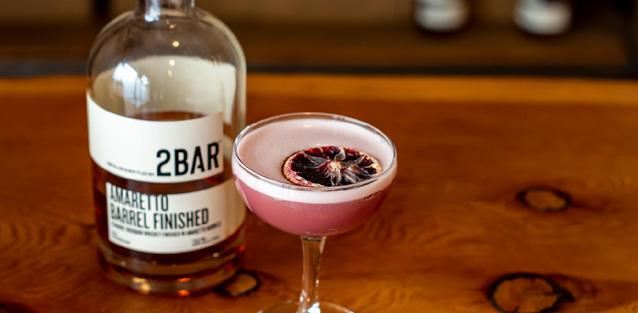
Bourbon Cold Brew Coffee
1 1/2 2BAR Bourbon 80 proof 1/2 oz Kahlua 2 dashes Chocolate Bitters 3 oz Cold Brew Coffee Shake with ice and strain into iced high ball glass, Top with whipped cream and mint sprig
Blood Orange Stone Sour
1 1/2 oz 2BAR Amaretto Barrel Finished Bourbon 3/4 oz Blood Orange Juice 1/4 oz Lemon Juice 1 oz simple syrup Egg white Dry shake for 1 minute, then add ice and shake again Strain into a Coupe Glass and garnish with orange
2Bar New York Sour
2oz 2BAR Wine Barrel Finish Bourbon 1 oz Lemon Juice 1oz Simple Syrup Shake with ice and Strain over iced rock glass Top with 1oz Red Wine, Cab or Syrah


